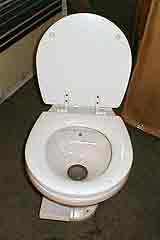Most RVers now indoor plumbing for granted. Though not exactly high-tech, RV plumbing is more complex than the household plumbing requiring more careful use and preventative maintenance. Most repairs require only basic plumbing skills, but like any project, do not take on any job that beyond your ability.

RV plumbing, especially toilets, are much more susceptible to damage than household ones so be careful with what you put into them. Never empty grease or oil into plumbing because these materials can congeal and become very hard to remove. Caustic cleaners or solvents can destroy plastic tanks, tubing and connections. Small food scraps can build up in waste tanks, so install screen drains in sinks. Do not flush paper towels, Q-tips, sanity napkins, Kleenex, etc. down toilets. Use RV toilet paper or cheap single or two-ply paper rather the more luxurious stuff. Test the dissolvability of the paper by putting a sheet in a cup of water and see if dissolves quickly.
Use only high quality, biogradable enzyme and bacterial tank treatments in holding tanks. Never use chemicals containing formaldehyde or homemade ones that contain pine oil or Pine Sol. Formaldehydes are dangerous to sewage treatment plants and septic systems, while pine oil can cause long term damage to the seals on the tank gate valves causing leakage.
While you can keep the gray water dump valve open at all times while hooked up to a sewer system, keep the valve on the black water tank closed. Because RV toilets flush using very little water, solid material can build up and dry out in the tanks so they are very hard to clean up, even to the point the tank must be replaced. By keeping the dump valve closed, solids are kept in suspension in the liquid. If you dump after traveling, you can take advantage of sloshing of liquids in the tanks to help break down the solids.
RVs usually have some type of sensor system to monitor fluid levels in tanks. These usually work trouble-free for years in fresh and gray water tanks, but not in black water tanks. If you notice that one of the holding tank sensors says that the tank is far from full, yet waste water is backing up into the toilet, sink, or shower it could mean a dirty in-tank sensor, most likely the one in the black water tank. Often this can be rectified by emptying and thoroughly rinsing out the tank. Then fill the tank with clean water and add the recommended quantity of bacteria type tank treatment liquid. Let the RV sit for a few days to let the bacteria “digest” all the accumulated crud as well as any toilet paper or organic material clinging to the sensors. Empty the tank and rinse out the tank before refilling.
Some people have had success in cleaning up very dirty black water tanks by adding a large bag of ice cubes to a few gallons of water after draining the tanks. They add some liquid dishwasher soap. Then they drive around for a couple of hours letting the ice cubes loosen the crud in the tank. Drain the tank after the ice cubes have melted. Incidentally, it is good idea to perform one of these procedure annually even if you do not experience sensor problems. This will ensure that holding tanks, sensors, and dump valves stay clean and trouble-free. If this does not cure the problem, it could be electrical or mechanical so you might have to take it to a professional to diagnose the problem and repair it.




